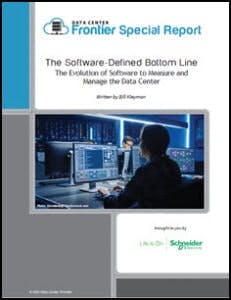Data center infrastructure is getting more complex and distributed and you’ll need software to measure and manage new data center assets. Defining an intelligent approach will define your success. This launches our article series on the evolution of data center management software.
Get the full report
In a growing connected economy, new demands require modern organizations to rethink how they effectively manage their data center environment. Beyond new requirements around the cloud, architectures around edge computing are also placing new strains on business and technology leaders. In a world of constant connectivity — performance, efficiency, uptime, and infrastructure visibility take center stage as leaders make decisions around their digital infrastructure.
To support new data center management requirements, data center professionals need to equip team leaders with the best possible tools. But what happens when too much information starts to create a problem?
IDC estimates that human error costs organizations over $62.4 million every year. A significant part of errors created by humans is because of tedious tasks and manual processes. Further, a recent Uptime Institute study points out that more than 70% of all data center outages are caused by human error and not by a fault in the infrastructure design. What does this cost when it all goes down? Quite a bit. According to Gartner, the average cost of IT downtime is $5,600 per minute but can be as much as $540,000 per hour. This is why it’s essential to have direct visibility into all assets and aspects of your data center operations. It becomes even more critical as your cloud, edge, and data center systems become further distributed.
Introduction
There is no slowdown in the data center industry. A new report from Fortune Business Insights indicates that the global demand for more efficient IT technologies combined with the economic advantages of modern, consolidated connectivity applications has contributed to the exponential rise in the scale and power of data centers. As the report points out, the global data center infrastructure market size is projected to reach $142.31 billion by 2027, compared to 2019, when the global market value stood at $94.56 billion.
The increase in usage of digital resources like social media, distributed applications, and a lot more data has resulted in further reliance on critical infrastructure. Furthermore, expanding utilization of data centers by companies amid the COVID-19 pandemic is fueling the growth of this market. Here’s another crucial point, the rapidly evolving competitiveness to remain a digital leader in the global market while leveraging advanced technologies such as cloud computing and Big Data have made it simpler and cheaper for enterprises to shift their workload to colocation data center partners. This means that organizations are finding growing value in working with colocation and hyperscale partners to ensure their workloads remain agile and support a distributed business environment.
However, it’s not always that easy to shift to better and less expensive ecosystems. There are still some real challenges facing distributed infrastructure as they work to support more users globally. As a connected society continues to rely on critical infrastructure, the growth around data center solutions also introduces a few road bumps. It’s important to understand that these issues impact larger hyperscale colocation sites and traditional enterprise data centers. Everyone is trying to overcome growing pains as more people use digital solutions. Consider these emerging challenges:
- Data Acquisition and Normalization. Data may be transmitted using different protocols, and there may be many different codes or names for one element
- Disaggregated Data and No Insights. Data is split across different subsystems that aren’t correlated, making KPIs challenging to measure and track.
- Unclear Root Causes. Bringing together data and insights to determine the root causes of operating issues can take a while.
- Non-Standard Operations. Standard workflow procedures aren’t created as issues arise.
- Non-Scalable Solutions and Closed Systems. Rapidly growing demands require scalable and rapidly deployable solutions that can keep up with retrofit or new build expansions.
- Lack of Direct Visibility into New Assets. Intelligent data center systems are helping administrators make better and more proactive decisions. However, legacy DCIM systems simply cannot keep up with all of the new devices connecting and sharing data within the data center. The other challenge with the new assets? The manual work involved adding new assets to a legacy DCIM system.
- Lack of Visibility into Distributed Architecture and the Edge. Here’s an important point. Many small edge IT installations are not staffed. In turn, this creates the challenge of having very limited visibility and access to all of these distributed assets. The main question for administrators is how to cost-effectively manage and maintain all of critical edge locations.
- Administrator Fatigue. The influx of information is actually slowing down data center administrative processes. With too much data, there are new challenges with alarm fatigue, swivel chair analysis issues, and even human error-related outages.
Managing a data center can be challenging, especially when operating multiple disparate systems with little connection between them. Balancing business growth and resource constraints presents a perpetual challenge for those who need to react quickly when finding operational solutions.
From Legacy to Modern: The Management Journey of Digital Infrastructure
To support emerging digital requirements, organizations are increasing their spending on critical data centers and cloud systems.
In 2020, we saw how data centers and digital infrastructure played an increasingly critical role in helping people stay connected. Growing infrastructure requirements created challenges for operators as they experienced more alarm fatigue, swivel chair analysis problems, and an overload of alerts. As the reliance on critical infrastructure grows, so does the challenge to manage it. Many leaders are now trying to shift the focus from putting out fires to creating more value in their infrastructure.
“IDC expects multi-cloud networking to benefit as enterprises, reeling from COVID-19, adopt infrastructure that enables viable business resiliency and continuity.” — Brad Casemore, research vice president, IDC’s Datacenter Networks
Looking ahead into 2022 and beyond, we see that we will be hitting the accelerator related to digital solutions.
“COVID-19 will take the wind from the sails of the data center network market during the middle part of 2020, but long-term growth prospects remain relatively bright, driven by continued demand from hyperscalers and other cloud customers and by enterprises modernizing and extending their datacenter networks for hybrid IT and multi-cloud. IDC expects multi-cloud networking to benefit as enterprises, reeling from COVID-19, adopt infrastructure that enables viable business resiliency and continuity.” — Brad Casemore, research vice president, IDC’s Datacenter Networks.
With this significant shift around data center resources and applications, organizations are faced with a new kind of challenge. In an era of digital users, how do you ensure optimal performance, infrastructure management, and productivity?
How Digital Modernization Impacts Physical Infrastructure Management
Leaders in the IT and business space have a clearer understanding of where their physical infrastructure plays a crucial role in digital modernization efforts. Without a data center management strategy and technology foundation, modernization projects will be a challenge. There are some key trends to be aware of related to these emerging transformation and modernization efforts.
Distributing computing: Edge, 5G, IoT, and more. As the potential next iteration of connectivity, 5G solutions have been marketed and talked about quite a lot. But is this just a marketing fad? Will these technologies hit the mainstream? The short answer is yes. Beyond 4G LTE solutions, there needed to be an evolution in connecting and sharing rich content and critical workloads. So, since the first 5G network went live in April 2019, there have been quite a few advancements and updates already.
According to Gartner, 5G was one of the main drivers for mobility in 2020, with the market for 5G infrastructure hitting more than $4 billion, with two-thirds of companies deploying 5G in 2020.
There have already been some pretty unique use- cases as far as real-world adoption. 5G is poised to change how we game, work and enjoy life outside of new and emerging edge solutions. For example, innovative startups find new ways to leverage 5G connectivity and create diverse new use cases. This includes immersive Multiview eSports streaming to the world’s first 5G VR headset.
Here’s another vital point: A recent report from Nokia indicated that over three-quarters (77%) of respondents found the use case of connected
equipment and cloud-connected robotics appealing, as they are vital enablers of Industry 4.0.
Responding companies noted that leveraging 5G alongside connected IIOT allows them to “readily visualize the benefits of 5G for real-time monitoring and remote control of machines they can’t currently control remotely.”
All of these new trends bring to light emerging considerations around the cloud and data center balance. They also bring up new challenges around remote infrastructure management to ensure that workloads are delivered as efficiently and resiliently as possible. The emergence of new connectivity solutions, like 5G, also changes the way data center leaders manage their physical infrastructure. We’ll discuss some of these emerging considerations below.
Going green and ESG is now a significant part of the transformation effort (and it’s excellent for the business). Efficiency, modernization, and green solutions go hand-in-hand. However, too often, ensuring that your design is green or sustainable is left towards the end of an architectural discussion.
“You will perform better financially by doing things like having a great sustainability program” — Jeffrey Hollender, professor
of sustainability at NYU Stern
Going green isn’t only good for the environment; it’s also great for business. There have already been numerous studies indicating that going green and efficiently using energy is excellent for the company. For example, a recent study shows that S&P 500 organizations with sustainability initiatives and technologies built into their overall strategy will outperform those who don’t. According to the report, these organizations see an 18% higher ROI because of how efficiently they manage and plan for climate change and energy utilization.
“You will perform better financially by doing things like having a great sustainability program” says Jeffrey Hollender, professor of sustainability at NYU Stern.
Further, researchers from Harvard Business Review recently stated, “We’ve been studying the sustainability initiatives of 30 large corporations for some time. Our research shows that sustainability is a mother lode of organizational and technological innovations that yield both bottom-line and top-line returns.”
“We’ve been studying the sustainability initiatives of 30 large corporations for some time. Our research shows that sustainability is a mother lode of organizational and technological innovations that yield both bottom-line and top-line returns.” — Harvard Business Review
Numerous reports have indicated that greener business does better in a digital economy. This is why you need to deploy data center management systems that allow for power and thermal monitoring capabilities to improve power usage efficiency (PUE) and reduce power and cooling costs. At the component level, make sure you’re deploying systems positioned as green technologies — also, the more visibility into these systems, the better. Here, you’ll be able to make adjustments in near real-time to ensure improved uptime and efficiency.
With all of these new trends come serious considerations around deployment and ensuring that you’re meeting the needs and demands of your customer.
Download the entire paper, “The Software Defined Bottom Line,” courtesy of Schneider Electric, to learn more about the evolution of data center management software. In our next article, we’ll take a deeper look at the solutions and systems managing some of the most critical infrastructures in the world.
About the Author



